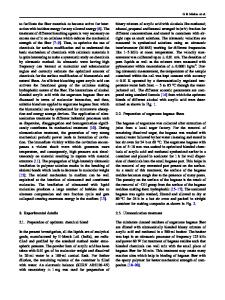Synthesis, Characterization and Application of Thin Film Carbon Nanotube Material
- PDF / 1,085,510 Bytes
- 6 Pages / 612 x 792 pts (letter) Page_size
- 37 Downloads / 361 Views
Synthesis, Characterization and Application of Thin Film Carbon Nanotube Material Alexander N. Obraztsov1,2 and Alexander P. Volkov1 1 Moscow State University, Faculty of Physics Moscow 119899, Russia 2 Kochi University of Technology, Kochi 782-8502, Japan ABSTRACT The non-catalytical chemical vapor deposition (CVD) method was used to grow carbon thin film material consisting of plate-like nanosized graphite crystallites and multiwall carbon nanotubes with predominant orientation of both species by their crystallographic plane, corresponding to a graphite basal plane, along a normal to the film surface. A number of experimental techniques was used for examination and characterization of the film phase composition, morphology, and electron properties peculiarities. Low-field electron emission with highly density of emission sites and emission current was obtained for the film material and allow to demonstrate their applicability for sealed prototypes of light-emitting devices. INTRODUCTION The various carbon materials have attracted a great attention during a long time a for cold cathode fabrication. The main advantage of diamond and diamond-like carbon (DLC) was believed traditionally due to their negative electron affinity (NEA) [1-3]. But NEA at the emitter surface corresponds to extremely low electron conductivity due to wide band gap of these materials (see for example [3]). A practical impossibility for n-type shallow doping of diamond [4] has stimulated an idea to use the polycrystalline CVD diamond films where the conductivity is possible due to surface defects and/or non-diamond carbon inclusions [3,5,6]. On the other hand, it is a many forms of the non-diamond carbon known to be rather efficient field emitters (FE), including carbon fibers [7], micro-roughed [8], powder-like [9] and ion-irradiated [10] graphite. Also, recently discovered carbon nanotubes have displayed the excellent FE properties [11-13]. In the recent publications we have shown that for a set of CVD films the FE efficiency is gradually increased with non-diamond carbon percentage. And the best emissivity, that is the lowest threshold field - lower than 1.5 V/µm, the highest density of emission sites - more than 106 cm-2, and density of emission current - more than 100 mA/cm2, at moderate field of 5 V/µm, was obtained for the film material consisted from nanostructured graphite-like species in form of nanosized crystallites and carbon nanotubes [15-17]. This experimental observation of the correlation between FE efficiency and the film graphitization rate allows us to suggest that the low-field electron emission (that is FE with an average electrical field lower than 10 V/µm) from polycrystalline CVD diamond is determined by their non-diamond graphite-like part only. It is supposed also similarity of the low-field emission mechanism for carbon nanotubes and other materials with graphite-like structure. These suggestions are in good agreement with the numerous experimental observations (see for example [18,19]) except the cases when prominen
Data Loading...











